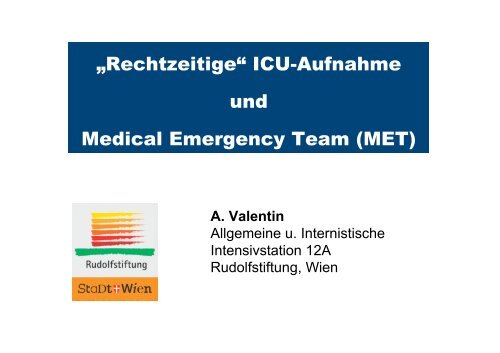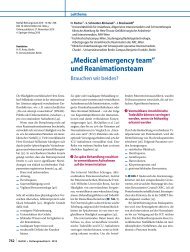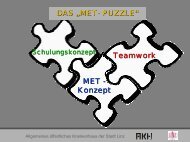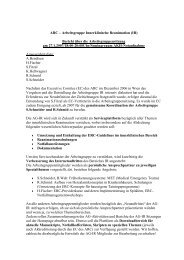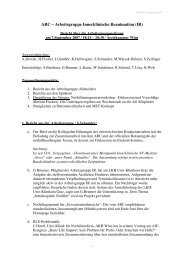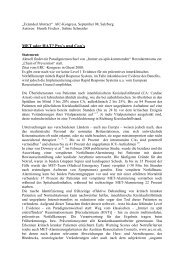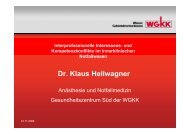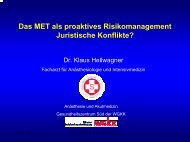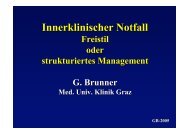ICU-Aufnahme und Medical Emergency Team - Austrian ...
ICU-Aufnahme und Medical Emergency Team - Austrian ...
ICU-Aufnahme und Medical Emergency Team - Austrian ...
- No tags were found...
Create successful ePaper yourself
Turn your PDF publications into a flip-book with our unique Google optimized e-Paper software.
Ein Titel – 3 Themen• Schach dem „überflüssigen“ Tod auf derNormalstation• Rechtzeitige <strong>ICU</strong>-<strong>Aufnahme</strong>oder ?Rechtzeitige Intensivmedizinische Versorgung• <strong>Medical</strong> <strong>Emergency</strong> <strong>Team</strong>
Der kritisch kranke PatientSmith G, BMJ 1999
Confidential inquiry into quality of care beforeadmission to intensive careMcQuillan, BMJ 1999100 Patienten – retrospektive Beurteilung durch 2 Reviewer• Suboptimale Behandlungvor <strong>ICU</strong>-<strong>Aufnahme</strong>: 56%• Verspätete <strong>ICU</strong>-<strong>Aufnahme</strong>: 39%• <strong>ICU</strong> <strong>Aufnahme</strong>bei optimaler Versorgung vermeidbar: 4 - 41%• Morbidität / Mortalitätdurch suboptimale Behandlung beeinflusst: 32%
Analysis of 118 adult cardiac arrests• 3.8/1000 admissions• Survival to hospital discharge: 14%• Expert panel: 66% of cardiac arrest potentiallyavoidable– 100% inadaequate treatment prior to the arrest– 77% delay in diagnosis– 58% error in diagnosis– 58% failure/indadaequate response to abnormal lab results– 48% no reaction to clinical signs of deterioration– 35% delay by nursing staff to inform physician– 29% delay by a physician to respond to nurse request– 24% failure in interpretation of radiographsHodgetts K, Resuscitation 2002
Sandroni C, Int Care Med 2007Review: In-hospital CPRIncidence of cardiac arrest:1-5 per 1000 admissions0.175 per bed/yearVF/VT: 25-35%Survival to hospital discharge~ 20%
Innerklinische Reanimation in ÖsterreichJahrPatientenLebendentlassen (%)Valentin A*199525320Schneider S199623621Valentin A**200325327Gombotz H*200643928* Resuscitation, **Intensive Care Med / congress abstract
First documented rhythm and clinical outcome fromin-hospital cardiac arrest among children and adults.Nadkarni VM, JAMA 2006253 US and Canadian hospitalsAdult cardiac arrest (n = 36.902)Conditions before cardiac arrest%• Respiratory Insufficency 40• Arrhythmia 32• Renal insufficiency 31• Hypotension and hypoperfusion 27• Metabolic and electrolyte abnormality 18• Baseline depression in CNS function 13
Herzkreislaufstillstand - ein vermeidbares Ereignis ?Pathophysiologische Veränderungen vor Ereignis• Respiratorisch 38%• Metabolisch 11%• Kardial 9%• Neurologisch 6%• Multiple 27%Klinische Verschlechterung + neue Symptome 84%• v.a. respiratorisch u. neurologisch• in den letzten 8h vor HKSSchein et al, Chest 1990
The course of critical illnessAngus DC, adapted from Cook D; Intensive Care Med (2003)
Zielsetzungen• Reanimation:verhüten ist besser als durchführen• Rechtzeitige Erkennung einerKrisensituation• Frühwarnsystem• Abfangen einer krisenhaften Entwicklung• Rechtzeitige <strong>Aufnahme</strong> an <strong>ICU</strong>, IMC
RichtigerZeitpunkt / <strong>Team</strong> / Ort / AblaufNFAOP<strong>ICU</strong>ASTDIAGErkennen - Handeln
Chalfin DB, Crit Care Med 2007Gibt es eine zeitgerechte <strong>ICU</strong>-<strong>Aufnahme</strong> ?EDn=50.322Zeit vor <strong>ICU</strong><strong>Aufnahme</strong>6hn=49.286 n=1036Beatmung 29,5% 39,3% p
Der Prozess IntensivmedizinNFAOPIntensivmedizinASTDIAG
Intensive care outside the <strong>ICU</strong>Early goal directed therapyIn the treatment of severe sepsisand septic shockRivers E, NEJM 2001
Facing the challenge:Intensive care without walls
<strong>Medical</strong> <strong>Emergency</strong> <strong>Team</strong> (MET)Patient at Risk <strong>Team</strong> (PART)Rapid Response <strong>Team</strong> (RRT)Critical Care Outreach <strong>Team</strong> (CCOT)
Kritisch krankerPatientKeineVitalzeichenHerzalarmMETAlarmierungBasic Life SupportAdvanced Life supportStabilisierung DNR <strong>ICU</strong>-<strong>Aufnahme</strong>Pat. verstirbt
Fragestellungenfür Rapid Response System• Trigger ?• Wer kann aktivieren ?• Kulturelle Veränderung – Aktivierung ausserhalbder üblichen Hierarchie• Personelle Zusammensetzung• Regionale <strong>und</strong> fachliche Zuständigkeit• Zeitlicher Response• 24h-Bereitschaft
<strong>Austrian</strong> Resuscitation Council 2004
Prevalence and sensitivity of MET-criteria in aScandinavian University HospitalBell MB, Resuscitation 2006Study cohort: 895 ptsStudycriteriaRespiratoryRateOne or morefullfilled30Heart Rate130Systolic BP
Cretikos M, Resuscitation 2007• Cardiac Arrest• Unplanned <strong>ICU</strong> admission• Unexpected death%95% CIBest achievablePPV = 15.7%SensitivitySpecifity49.193.744.4-53.891.2-95.684% ofMET activationsfor wrong pts ?PPVNPV9.899.28.7-11.199.1-99.3
Activation criteria for a medical emergency teamHodgetts, Resuscitation 2002
Systematic review and evaluation of physiological track andtrigger warning systems for identifying at-risk patients onthe ward. Gao H, Int Care Med 200715 datasets (warning systems)MedianQuartilesSensitivity43.325.4-69.2Specifity89.564.2-95.7PPV36.729.3-43.8NPV94.389.5-97•Sensitivity was poor•Available data were insufficient to identify the best TT
Dokumentierte Vitalzeichen während 24h vorHerzkreislaufstillstand56 PatientenNurmi J, Acta Anaesthesiol 2005
Patient monitoring and the timing of cardiac arrests and medicalemergency team calls in a teaching hospitalJones D. Int Care Med 2006
SystemänderungProzessänderung• Problem thematisieren• Akzeptanz für gemeinsame Lösung• Änderung der Organisationskultur• Ausbildung– Alarmierungskriterien– Alarmierung– MET-mitglieder• Implementierung• Evaluierung
Findings of the First Consensus Conference on<strong>Medical</strong> <strong>Emergency</strong> <strong>Team</strong>sDeVita MA, CCM 2006Non-DNR cardiac arrestsper 1000 dischargesNon-DNR deathsper 1000 dischargesUnplanned <strong>ICU</strong> admissionsper 1000 dischargesOutcome
Ergebnisse von MET-StudienNaeem N, Resuscitation 2005• Teils kleine Fallzahlen• Meist Observation, keine Randomisierung• KH-Strukturen: Australien, UK, US
MERIT STUDYEducationNo Education
Introduction of the medical emergency team (MET)system: a cluster-randomised controlled trialMERIT study investigators, Lancet 2005Outcomeper 1000admissionsControl hospitalsBaselineStudyMET hospitalsBaselineStudyStatisticsPrimaryOutcome7.15.96.65.3nsCardiacarrest2.61.61.61.3nsUnplan.<strong>ICU</strong> adm.5.35.04.74.2nsUnexpect.death1.61.21.61.1ns
Fragen zur MERIT study• MET ineffektiv ?• MET effektiv, aber inadäquat implementiert ?• Falsche Outcomeparameter gewählt ?• „Kontamination“ der Kontroll-Spitäler ?• Funktion von Reanimationsteams als „informelle METs“ ?• Spitäler nicht representativ ?• Implementierungs- u. Studienperiode zu kurz ?• Statistische Power inadäquat ?
Rapid Response Systems: A Systematic ReviewWinters C, Crit Care Med 2007Hospital mortalityObservational studiesCluster-randomised trials
Rapid Response Systems: A Systematic ReviewWinters C, Crit Care Med 2007Cardiac ArrestOR 0.94(95% CI 0.79-1.13)Observational studiesCluster-randomised trials
Sebat F, Crit Care Med 2007A focus on high-risk patients (shock)
Effect of the medical emergency team on longtermmortality following major surgeryJones D, Crit Care 2007METMultivariate analysis -death at 1500 days:OR: 0.7795% CI: 0.64-0.92
Post-<strong>ICU</strong> Mortality as % of Hospital MortalityAuthorBastos, 1966Rubins, 1988Moreno, 1997SAPS 3 investigators, 2005Smith, 1999Goldhill, 1998Valentin, ASDI, 2003Moreno, 2001Rowan, 1993CountryBrasilUSAPortugalSAPS 3UKUKAustriaEUR<strong>ICU</strong>S IIUKPost-<strong>ICU</strong> Mortality(%)15222424.62527303335
ASDIÖ STER RE ICH ISC HES ZEN TRU M FÜRD OK UM EN TA TION U ND QU ALIT ÄTS-SIC HERU NG IN DE R INTE NSIVM ED IZIN<strong>ICU</strong> vs. Post <strong>ICU</strong> Mortality:Distribution (%) by risk of death (SAPS II)100%90%80%% of all deaths70%60%50%40%<strong>ICU</strong><strong>ICU</strong><strong>ICU</strong><strong>ICU</strong><strong>ICU</strong>30%20%10%0%post<strong>ICU</strong>post<strong>ICU</strong>post<strong>ICU</strong>0,0-0,2 0,2-0,4 0,4-0,6 0,6-0,8 0,8-1,0SAPS II risk of deathpost<strong>ICU</strong>post<strong>ICU</strong>
n=23.097Patients at risk ?Young L,Resuscitation 200823% within 24hafter <strong>ICU</strong> dischargeMET38/1000 AdmissionsAdvanced Life supportLeft on ward 75% Died 1.6% <strong>ICU</strong> 15%Died 2.7%
Rapid Response System:Ein sicheres NetzwerkNFAIMC<strong>ICU</strong>IMCAST
Wie häufig ist eine MET-Aktivierung ?MET-Aktivierungenpro 1000 <strong>Aufnahme</strong>n• Kenward (2004) 2,5• De Vita (2004) 25,8• Jones (2006) 40,6
Long term effect of a medical emergency team oncardiac arrests in a teaching hospitalJones D, Crit Care 2005Prevention of 1 Cardiac Arrest / every 17 MET calls
<strong>Medical</strong> emergency teams: a strategy for improving patientcare and nursing work environments.Galhotra S, J Adv Nurs 2006Nurses familiar with MET activation criteriaNurses that had called a condition C or ANurses saying MET response improves patientcareNurses saying MET responseImproves nursing work environmentNurses likely to consider MET responseas a factor in future job decision-making98%89%94%84%65%
University ofPittsburgh<strong>Medical</strong> emergency teams: a strategy for improving patientcare and nursing work environments.Galhotra S, J Adv Nurs 2006
Rapid Response SystemMedizinisches Notfallteam• RRS fördert das rechtzeitige <strong>und</strong> systematische Erkennen<strong>und</strong> Management kritischer Situationen• RRS verringert Frequenz notwendiger Reanimationen<strong>und</strong> ungeplanter <strong>ICU</strong>-<strong>Aufnahme</strong>n• Post-<strong>ICU</strong> Betreuung wesentliche Aufgabe des RRS• Organisationsstruktur kann nur auf lokaler Ebeneerarbeitet werden.• Paradigmenwechsel ist notwendig:Frage ist nicht wo (?) sondern wie rasch (?) stehtintensivmedizinische Kompetenz zur Verfügung


